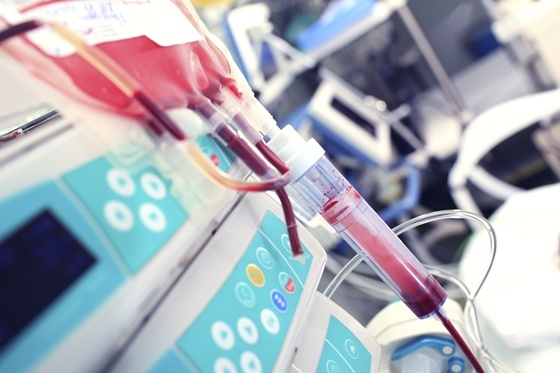
Doctors have been using stem cells in transplants for more than 60 years. The first successful stem cell transplant happened in 1956 between siblings who were identical twins, using hematopoietic stem cells from the bone marrow (Hematopoietic Stem Cell Transplantation, 2015).
Since then, scientists have discovered a number of other stem cell sources including the umbilical cord blood and peripheral blood. Currently, stem cells are used to treat more than 80 conditions and have saved the lives of thousands of people around the world (Corcell, 2015).
Let’s take a look at the types of stem cells often used in transplants as well as the most common stem cell sources.
Hematopoietic Stem Cells
 Hematopoietic stem cells (HSCs) are a special type of blood cell that has the ability to create new blood cells. They primarily reside in the bone marrow, which is in the centre of some bones.
Hematopoietic stem cells (HSCs) are a special type of blood cell that has the ability to create new blood cells. They primarily reside in the bone marrow, which is in the centre of some bones.
HSCs can re-establish the body’s ability to generate healthy blood cells and are also responsible for creating cells that power the body’s immune system.
While there are dozens of clinical trials examining the potential use of many types of stem cells ─ all current standard stem cell transplant are using hematopoietic stem cells.
3 Primary Sources of Hematopoietic Stem Cells
1. Bone Marrow – is the most common source of stem cells used for transplants. The pelvis is a rich source of bone marrow stem cells.
Once extracted, the bone marrow is filtered then preserved, ready for transplantation. It is transfused into the recipient through a vein, in the same way as a blood transfusion. Bone marrow stem cells then go through a process called ‘engraftment’, where they embed themselves in the recipient’s bone marrow and begin to generate blood cells (Cancer.org, 2015).
2. Peripheral Blood – normally, there are very few HSCs in a person’s bloodstream. However, scientists have discovered that certain growth hormones can greatly increase the number of stem cells in the bloodstream for a short period.
The stem cells are preserved in the same way as bone marrow stem cells. However, the stem cells found in the peripheral blood can go through the engraftment process faster than the stem cells from bone marrow. They can begin producing healthy blood cells in the recipient’s body in as little as 10 days (Cancer.org, 2015).
3. Umbilical Cord Blood – a newborn baby’s umbilical cord is a rich source of stem cells, including HSCs. The stem cells found in umbilical cord blood are less mature than peripheral stem cells and bone marrow stem cells. That makes cord blood stem cells less likely to be rejected by the recipient’s immune system. Immature cells are also less likely to trigger Graft Versus Host Disease (GVHD), where the donor’s cells begin to attack the transplanted stem cells (Macmillian.org.uk, 2015).
The first successful transplant using cord blood stem cells happened in 1988. The recipient is a young boy suffering from Fanconi Anemia and the stem cells came from his baby sister’s umbilical cord blood. More than 30,000 cord blood stem cell transplants have occurred since then (Ballen, Gluckman & Broxmeyer, 2013). And about 1 in 3 transplants are now done using stem cells found in umbilical cord blood (Cancer.org, 2015)
FREE Guide to Cord Blood Banking Basics – Download Here Now! >>
Stem Cell Sources and Compatibility
There are two types of stem cell treatment (Verter, 2015):
- Allogenic – where a recipient receive stem cells from a matching donor who may or may not be related to the recipient.
- Autologous – where a recipient receives their own stem cells in transplants.
Before stem cell transplantation, a procedure called ‘HLA Matching’ is done to determine if a donor’s stem cells will be compatible with the recipient. Human leukocyte antigen (HLA) is a protein that is found on most cells in the human body. It informs the body if a cell belongs to a person or if it is a foreign entity that must be attacked (Bethematch.org, 2015).
Other Types of Stem Cells
Research is still ongoing into the potential use of other types of stem cells in transplants. Many of the stem cells being researched are multipotent, which means they can transform into other types of cells including nerve cells, skin, ligaments, heart cells and neural cells.
Researchers hope to use these types of stem cells to treat many conditions including Parkinson’s disease, Alzheimer’s disease, diabetes, and heart disease (Cirm.ca.gov, 2015). Once some of these exciting research projects come to fruition, the ways in which medical experts use stem cells in transplants will greatly improve.
Sources
Bethematch.org,. (2015). HLA matching. Retrieved 12 October 2015, from https://bethematch.org/for-patients-and-families/finding-a-donor/hla-matching/
Cancer.org,. (2015). Sources of stem cells for transplant. Retrieved 11 October 2015, from www.cancer.org/treatment/treatmentsandsideeffects/treatmenttypes/bonemarrowandperipheralbloodstemcelltransplant/stem-cell-transplant-stem-cell-sources
Cirm.ca.gov,. (2015). The Power of Stem Cells | California’s Stem Cell Agency. Retrieved 12 October 2015, from https://www.cirm.ca.gov/patients/power-stem-cells
Corcell. (2015). Diseases Treated | Cord Blood Storage | CorCell. CorCell. Retrieved 11 October 2015, from www.corcell.com/benefits-of-umbilical-cord-blood/diseases-treated/
Hematopoietic Stem Cell Transplantation. (2015). Retrieved 11 October 2015, from www.biomed.brown.edu/Courses/BI108/BI108_2007_Groups/group03/history.html
Macmillan.org.uk,. (2015). Graft-versus-host disease (GvHD) – Information and support – Macmillan Cancer Support. Retrieved 12 October 2015, from http://www.macmillan.org.uk/information-and-support/treating/stem-cell-and-bone-marrow-transplants/side-effects-of-allogeneic-donor-stem-cell-transplants/graft-versus-host-disease.html
Verter, D. (2015). Parent’s Guide to Cord Blood. Parentsguidecordblood.org. Retrieved 12 October 2015, from www.parentsguidecordblood.org/diseases.php
{{cta(‘010124f3-c9bc-4a23-b9fc-74953e6288c9’)}}


